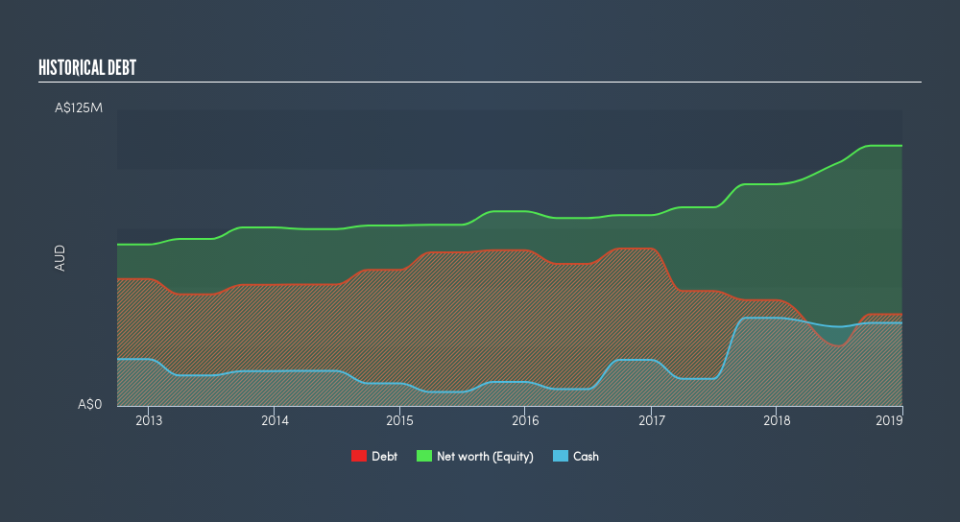What Investors Should Know About Schaffer Corporation Limited's (ASX:SFC) Financial Strength

Want to participate in a short research study? Help shape the future of investing tools and you could win a $250 gift card!
Schaffer Corporation Limited (ASX:SFC) is a small-cap stock with a market capitalization of AU$190m. While investors primarily focus on the growth potential and competitive landscape of the small-cap companies, they end up ignoring a key aspect, which could be the biggest threat to its existence: its financial health. Why is it important? Assessing first and foremost the financial health is essential, as mismanagement of capital can lead to bankruptcies, which occur at a higher rate for small-caps. The following basic checks can help you get a picture of the company's balance sheet strength. Nevertheless, these checks don't give you a full picture, so I’d encourage you to dig deeper yourself into SFC here.
SFC’s Debt (And Cash Flows)
SFC has built up its total debt levels in the last twelve months, from AU$45m to AU$49m – this includes long-term debt. With this increase in debt, SFC's cash and short-term investments stands at AU$35m , ready to be used for running the business. Moreover, SFC has produced AU$28m in operating cash flow during the same period of time, leading to an operating cash to total debt ratio of 57%, meaning that SFC’s debt is appropriately covered by operating cash.
Can SFC meet its short-term obligations with the cash in hand?
At the current liabilities level of AU$47m, it appears that the company has been able to meet these commitments with a current assets level of AU$117m, leading to a 2.46x current account ratio. The current ratio is calculated by dividing current assets by current liabilities. Generally, for Auto Components companies, this is a reasonable ratio since there is a bit of a cash buffer without leaving too much capital in a low-return environment.
Does SFC face the risk of succumbing to its debt-load?
With debt reaching 45% of equity, SFC may be thought of as relatively highly levered. This is somewhat unusual for small-caps companies, since lenders are often hesitant to provide attractive interest rates to less-established businesses. No matter how high the company’s debt, if it can easily cover the interest payments, it’s considered to be efficient with its use of excess leverage. A company generating earnings before interest and tax (EBIT) at least three times its net interest payments is considered financially sound. In SFC's case, the ratio of 20.87x suggests that interest is comfortably covered, which means that lenders may be willing to lend out more funding as SFC’s high interest coverage is seen as responsible and safe practice.
Next Steps:
SFC’s high cash coverage means that, although its debt levels are high, the company is able to utilise its borrowings efficiently in order to generate cash flow. This may mean this is an optimal capital structure for the business, given that it is also meeting its short-term commitment. I admit this is a fairly basic analysis for SFC's financial health. Other important fundamentals need to be considered alongside. I recommend you continue to research Schaffer to get a better picture of the small-cap by looking at:
Future Outlook: What are well-informed industry analysts predicting for SFC’s future growth? Take a look at our free research report of analyst consensus for SFC’s outlook.
Valuation: What is SFC worth today? Is the stock undervalued, even when its growth outlook is factored into its intrinsic value? The intrinsic value infographic in our free research report helps visualize whether SFC is currently mispriced by the market.
Other High-Performing Stocks: Are there other stocks that provide better prospects with proven track records? Explore our free list of these great stocks here.
We aim to bring you long-term focused research analysis driven by fundamental data. Note that our analysis may not factor in the latest price-sensitive company announcements or qualitative material.
If you spot an error that warrants correction, please contact the editor at editorial-team@simplywallst.com. This article by Simply Wall St is general in nature. It does not constitute a recommendation to buy or sell any stock, and does not take account of your objectives, or your financial situation. Simply Wall St has no position in the stocks mentioned. Thank you for reading.


